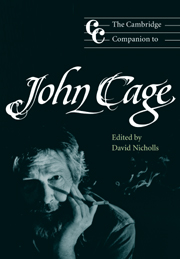6 - Towards infinity: Cage in the 1950s and 1960s
from Part II - Sounds, words, images
Published online by Cambridge University Press: 28 September 2011
Summary
The 1950s and 1960s were, arguably, the most important decades of Cage's creative life. During that period, he moved in his work from determinacy to indeterminacy, from conventional notation to graphic and texted notation, from standard instrumental resources to technology and “the entire field of sound” (Cage c. 1938–40, p. 4), from music to theatre, and – in terms of performance space – from the concert hall to the world at large. He also started to engage in a serious way with words and images, and – domestically – moved from the noise and bustle of New York City to the peace and tranquility of Stony Point, in New York State. Finally, willingly or otherwise, he exchanged relative anonymity for relative notoriety, and – for the first time in his artistic life – found himself having to respond to commissions. As he put it in 1971, “Roughly I would say 1952, or perhaps 1954, [was] the turning point. Before that time, I had to make the effort to get [my work] performed. Now other people make the effort and I have to respond by travelling” (Kostelanetz 1988, p. 101). Unsurprisingly therefore, given the importance of this period, many of Cage's multifarious activities of the 1950s and 1960s are subjected to detailed analysis elsewhere in this volume; consequently, the present chapter attempts not to provide a closely argued critique of particular innovations or developments, but rather to create a contextual overview within which can be placed the various facets of Cage's work discussed elsewhere.
- Type
- Chapter
- Information
- The Cambridge Companion to John Cage , pp. 100 - 108Publisher: Cambridge University PressPrint publication year: 2002



